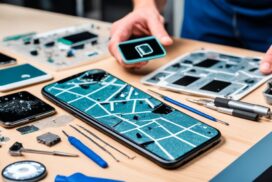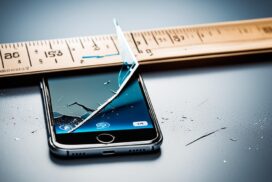Mobile Screen Repair Kits: What They Include and How to Use Them
Are you tired of staring at a cracked phone screen? If you’re looking for a cost-effective solution that allows you to repair your phone’s display at home, mobile screen repair kits are the answer. These kits provide everything you need to perform a DIY screen repair and bring your phone back to its former glory.
Mobile screen repair kits have come a long way in terms of quality and compatibility. With official components available from manufacturers like Apple and Google, you can trust that the replacement parts included in these kits are of the highest standard.
What exactly do these kits include? Well, you’ll find all the necessary tools and replacement parts needed to complete the repair process. From adhesive and suction cups to specialized tools like opening picks and screwdrivers, these kits have got you covered. Depending on the extent of the damage, they may even include replacement screens or glass.
Using a mobile screen repair kit is not rocket science, but it’s important to follow the step-by-step instructions provided. Softening the adhesive, removing the screen, disconnecting cables, applying new adhesive, and installing the replacement screen are all part of the process. As long as you take your time, exercise caution, and use the appropriate tools, you’ll be able to successfully repair your phone’s screen.
But what about the challenges? DIY screen repair can be tricky, especially for first-time users. The strong adhesive used to hold the screen in place can make removal difficult, and misalignment during installation is a common issue. However, by reading the instructions carefully, watching video tutorials, and seeking help from online communities, you can overcome these challenges and achieve a successful repair.
Now, let’s talk cost. DIY screen repair is a cost-effective alternative to professional repair services. Although the upfront cost of a repair kit may seem higher than the fees charged by third-party repair shops, it provides long-term savings. You only pay for the replacement parts, and you can potentially reuse the kit for future repairs. However, it’s important to consider the complexity of the repair and your own skill level before deciding whether to attempt a DIY repair or seek professional assistance.
Diving into the world of DIY screen repair offers several benefits. Firstly, it’s convenient. You can complete the repair at your own pace and in the comfort of your own home. Secondly, it’s empowering. Taking control of your device’s maintenance and repairs can give you a real sense of accomplishment. And finally, DIY repairs usually have shorter downtimes compared to waiting for an appointment or sending your device to a repair center.
Major manufacturers like Apple and Google have even introduced self-service repair programs, providing users with the option to purchase official repair parts directly from the source. However, it’s important to note that self-service repairs may void your device’s warranty, so be sure to consider the implications before proceeding.
In conclusion, mobile screen repair kits offer a convenient and cost-effective way to fix your phone’s display at home. With the right tools, replacement parts, and careful attention to detail, you can achieve a successful DIY repair. So why wait? Say goodbye to that cracked screen and give your phone the care it deserves with a mobile screen repair kit.
What’s Included in Mobile Screen Repair Kits?
Mobile screen repair kits are comprehensive packages that contain all the necessary tools, replacement parts, adhesive, and instructions needed to repair a damaged mobile phone screen. These kits are designed to provide convenience and ensure a successful DIY screen repair process. Let’s take a closer look at the contents typically found in these kits:
Repair Tools:
- Screwdrivers: These tools come in various sizes and types, allowing you to remove the necessary screws to access the screen.
- Suction Cups: These are used to safely lift the damaged screen away from the device’s body without causing any further damage.
- Opening Picks: These thin and flexible tools help separate the adhesive and pry open the device’s casing.
- Spudger: A spudger is a versatile tool that assists in disconnecting cables and removing small components during the repair process.
- Specialized Tools: Depending on the specific kit, you may also find additional tools like tweezers or pry bars.
Replacement Parts:
- Replacement Screens or Glass: Mobile screen repair kits provide compatible replacement screens or glass, depending on the extent of the damage. These components are designed to replicate the original screen quality and functionality.
Adhesive:
- Adhesive is a crucial component of the repair process. It ensures that the replacement screen is securely attached to the device’s body. Mobile screen repair kits often include adhesive strips or glue specifically designed for phone screen repairs.
Instructions:
Comprehensive instructions guide you through the entire repair process, ensuring that you have a clear understanding of each step. These instructions outline the necessary precautions, tools to be used, and provide valuable tips to help you achieve a successful repair.
Additionally, some mobile screen repair kits may include extra accessories such as alcohol wipes and cleaning cloths. These accessories help prepare the device for repair by cleaning dust, fingerprints, and other contaminants that may affect the screen’s adhesive bond.
Remember, it’s essential to carefully review the specific contents of the mobile screen repair kit you choose before making a purchase. This ensures that it aligns with your repair needs and provides all the necessary tools and components for a successful DIY screen repair.
Step-by-Step Guide for Using Mobile Screen Repair Kits
Using a mobile screen repair kit is a straightforward process that can save you time and money. By following these step-by-step instructions, you can successfully repair your phone’s screen at home.
Step 1: Soften the Adhesive
Start by heating the adhesive that holds the screen in place. This can be done using a heat gun or a hairdryer set to a low heat setting. Gently apply heat to the edges of the screen, moving it around to avoid overheating any one area. The heat will help loosen the adhesive, making it easier to remove the screen.
Step 2: Remove the Screen
Once the adhesive has softened, you can proceed to remove the screen. Use suction cups to lift the screen away from the device, creating a gap. Insert opening picks into the gap and gently slide them along the edges to release the screen from the adhesive. Be careful not to apply too much force as it may damage the screen or other components.
Step 3: Disconnect the Cables
After removing the screen, you’ll need to disconnect the cables that connect it to the device. Use a spudger or a small pry tool to gently lift the connectors and detach them from their sockets. Take note of the cable positions to ensure proper reassembly later.
Step 4: Remove Adhesive Residue
Once the screen is detached, there may be leftover adhesive residue on the device. Use adhesive remover or isopropyl alcohol and a microfiber cloth to gently clean the surface. Be thorough in removing any remaining adhesive to ensure a clean and secure installation of the replacement screen.
Step 5: Apply New Adhesive
Before installing the replacement screen, apply new adhesive to ensure a secure bond. Many repair kits come with pre-cut adhesive strips, making this step easier. Carefully align the adhesive with the edges of the device and press it firmly into place.
Step 6: Install the Replacement Screen
Finally, it’s time to install the new screen. Line up the connectors with their respective sockets and gently press the screen into place. Apply even pressure along the edges to ensure a proper seal with the adhesive. Once the screen is securely in place, reconnect any cables you disconnected earlier.
And there you have it! By following these step-by-step instructions, you can successfully use a mobile screen repair kit to replace your phone’s screen. Remember to refer to the specific instructions provided with your repair kit for any additional guidance or troubleshooting tips.
| DIY Screen Repair Steps | Benefits |
|---|---|
| 1. Soften the adhesive | – Cost-effective alternative to professional repair services |
| 2. Remove the screen | – Convenience and flexibility to repair at home |
| 3. Disconnect the cables | – Empowerment and control over device maintenance |
| 4. Remove adhesive residue | – Shorter downtime compared to waiting for a professional repair |
| 5. Apply new adhesive | – Satisfaction of successfully completing a DIY repair |
| 6. Install the replacement screen | – Opportunity to save money on labor costs |
Challenges and Tips for DIY Mobile Screen Repair
DIY mobile screen repair can pose several challenges, especially for first-time users. Overcoming these challenges requires careful consideration and troubleshooting. Here are some common issues and useful tips to help you navigate the DIY repair process:
Challenge 1: Difficulties in Screen Removal
One of the main challenges in DIY screen repair is dealing with the strong adhesive that holds the screen in place. This adhesive can make it hard to separate the screen from the device without causing damage. To overcome this challenge, follow these tips:
- Use a heat gun or a hairdryer set to low heat to soften the adhesive before attempting to remove the screen.
- Apply consistent and gentle pressure while using a suction cup and an opening pick to pry the screen away from the device.
- Be patient and take your time to avoid rushing the process, as this can lead to accidental damage.
Challenge 2: Misalignment of Connectors
During the installation process, it’s important to ensure that the connectors between the screen and the device are properly aligned. Misalignment can result in display issues or a non-responsive touch screen. To avoid this challenge, keep the following tips in mind:
- Carefully align the connectors and gently press them together until you feel a slight click.
- Double-check the alignment by turning on the device and testing the screen before fully reassembling the device.
- If you notice any issues with the screen’s functionality, carefully detach and reattach the connectors to ensure proper alignment.
Challenge 3: Dealing with Delicate Components
When performing a mobile screen repair, it’s essential to handle delicate components with care to avoid further damage. To overcome this challenge, follow these precautions:
- Work in a clean and well-lit area to minimize the risk of misplacing or damaging small components.
- Use proper tools, such as a spudger or tweezers, to delicately handle small connectors and cables.
- If you encounter any resistance or difficulty during the repair process, stop and reassess your approach to avoid causing unnecessary damage.
By following these troubleshooting tips and being cautious throughout the repair process, you can overcome common challenges and successfully repair your mobile phone’s screen.
Cost Comparison: DIY vs. Professional Phone Screen Repair
When it comes to fixing a broken phone screen, users have two main options: DIY repair or professional repair services. Both approaches have their pros and cons, and it’s important to consider the cost implications before making a decision.
DIY Phone Screen Repair Cost
DIY mobile screen repair kits provide an affordable alternative for those looking to save money. While the upfront cost of a repair kit may seem higher than the fees charged by third-party repair shops, it offers long-term cost savings. With a DIY approach, users only pay for the replacement parts and can potentially reuse the kit for future repairs.
Professional Repair Service
Professional repair services, on the other hand, often charge a premium for labor and the use of original parts. While these services may provide convenience and expertise, they can be more expensive than a DIY repair.
Third-Party Repair Shops
Some users may opt to take their phone to a third-party repair shop for screen replacement. These shops can offer competitive prices compared to official manufacturer repair programs. However, it’s essential to do thorough research and choose a reputable repair shop to ensure quality service and reliable replacement parts.
Manufacturer Repair Programs
Major manufacturers like Apple and Google have introduced official repair programs that provide users with genuine replacement parts. While these programs guarantee compatibility and quality, it’s important to consider the potential warranty implications. Sometimes, opting for a manufacturer repair program may void the device’s warranty.
Comparing the Costs
| DIY Repair | Professional Repair | |
|---|---|---|
| Upfront Cost | Cost of repair kit | Labor and parts |
| Long-term Cost | Savings by reusing the kit | No additional costs |
| Warranty Implications | N/A (depends on the device) | Potential voiding of warranty |
As shown in the table above, a DIY repair may require an investment in a repair kit initially. However, it offers long-term savings and the ability to reuse the kit for future repairs. On the other hand, professional repair services have no additional costs, but they can be more expensive upfront and may void the device’s warranty.
When deciding between DIY and professional phone screen repair, users should consider their skill level, the complexity of the repair, and the potential warranty implications. If confident in their abilities and looking to save money, DIY repair can be a cost-effective solution. However, for those who prefer the expertise and convenience of professional services, working with a reputable repair shop or considering manufacturer repair programs may be the best choice.
Benefits of DIY Mobile Screen Repair
DIY mobile screen repair offers several advantages over professional repair services. Firstly, it provides convenience, as users can complete the repair at their own pace and in the comfort of their own home. This means no more waiting in line or scheduling appointments at repair shops. With a DIY approach, users can start the repair process immediately, saving valuable time and eliminating unnecessary hassle.
Secondly, DIY mobile screen repair is cost-saving. By opting to repair their phone screens themselves, users can avoid paying for expensive labor costs associated with professional repairs. DIY kits generally consist of affordable replacement parts, significantly reducing the overall expense compared to professional services.
Moreover, the DIY approach empowers users to take control of their device’s maintenance and repairs. Instead of relying on external services, users can gain the knowledge and skills needed to fix their phone screens independently. This sense of empowerment can boost confidence and provide a greater understanding of one’s own devices.
Lastly, DIY repairs typically have shorter downtimes. Instead of waiting for an appointment or shipping the device to a repair center, users can immediately start the repair process. This means less time spent without a functioning phone and more control over one’s daily activities.
DIY mobile screen repair offers convenience, cost-saving, empowerment, and shorter downtime, making it an ideal choice for those looking for a hassle-free and economical solution to fix their phone screens.
| Advantages of DIY Mobile Screen Repair |
|---|
| Convenience |
| Cost-saving |
| Empowerment |
| Shorter Downtime |
Manufacturer-sponsored Repair Programs
Major manufacturers like Apple and Google have introduced self-service repair programs, offering official repair parts to consumers. These programs allow users to purchase genuine replacement parts directly from the manufacturers, ensuring compatibility and quality. However, it’s important to note that self-service repairs may void the device’s warranty, so users should carefully consider the implications before proceeding. Manufacturer-sponsored repair programs provide an additional option for users who prefer to use official parts and follow manufacturer-approved repair procedures.
When it comes to Apple, their Self Service Repair program grants customers access to official repair parts that are identical to those used by authorized technicians. This enables individuals to confidently repair their Apple devices at home while maintaining the device’s authenticity and performance. Similarly, Google offers their Pixel-phone repair program, which allows users to purchase authentic replacement parts for their Pixel phones.
By participating in these manufacturer-sponsored repair programs, users can ensure that they are using official repair parts that are specifically designed for their devices. This not only guarantees compatibility but also helps maintain the device’s reliability and durability. Furthermore, using official parts can help users restore their devices to their original state, preserving the overall user experience.
However, it’s important to acknowledge that there are potential warranty implications when opting for self-service repairs. Repairing a device using unofficial or unauthorized methods may result in the voiding of the manufacturer’s warranty. If the device experiences future issues, the manufacturer may refuse to provide free repairs or support. Therefore, users should carefully weigh the benefits of self-service repair against the potential loss of warranty coverage.
Benefits of Manufacturer-sponsored Repair Programs:
- Access to official repair parts
- Guaranteed compatibility and quality
- Maintains device authenticity and performance
- Preserves reliability and durability
Users who have adequate technical skills and are confident in their ability to perform repairs can benefit from these programs by having access to official parts and following manufacturer-approved procedures. However, it’s essential to thoroughly research and understand the warranty implications before embarking on a self-service repair journey.
Overall, manufacturer-sponsored repair programs offer a valuable option for users who prefer to utilize official repair parts and have the necessary skills to perform repairs at home. These programs provide greater flexibility and convenience while maintaining the integrity and authenticity of the device.
Conclusion
Mobile screen repair kits provide a practical solution for DIY enthusiasts looking to mend their phone’s display in the comfort of their own homes. These kits come complete with all the necessary tools and replacement parts, offering convenience and cost savings compared to professional repair services. However, it’s crucial to approach DIY repairs with caution, ensuring meticulous attention to detail and adherence to instructions for a successful outcome.
Considerations such as skill level, the complexity of the repair, and potential warranty implications should be taken into account before attempting a DIY repair. With proper preparation and careful execution, DIY mobile screen repair can be a rewarding and empowering experience.
Overall, the benefits of DIY phone screen repair include the ability to work at your own pace, cost savings from eliminating labor fees, and the satisfaction of taking control of device maintenance. However, it’s important to weigh these advantages against the potential challenges and the impact on the device’s warranty. By making an informed decision and following best practices, DIY mobile screen repair can provide a practical and cost-effective solution for those willing to take on the task.
FAQ
What tools and parts are included in mobile screen repair kits?
Mobile screen repair kits typically include adhesive, suction cups, opening picks, a spudger, screwdrivers, and other specialized tools. They also provide replacement screens or glass, depending on the extent of the damage.
What steps are involved in using a mobile screen repair kit?
Using a mobile screen repair kit involves softening the adhesive, removing the screen using suction cups and opening picks, disconnecting cables, removing adhesive residue, applying new adhesive, and installing the replacement screen.
What are the common challenges in DIY mobile screen repair?
Common challenges include difficulties in removing the screen due to strong adhesive, misalignment of connectors during installation, and dealing with delicate components.
How can I overcome challenges in DIY mobile screen repair?
To overcome challenges in DIY mobile screen repair, it’s crucial to read the instructions thoroughly, watch video tutorials, and seek help from online communities or forums for troubleshooting tips. Handling delicate components with caution and ensuring proper alignment of connectors can also prevent further damage.
How does the cost of DIY mobile screen repair compare to professional repair services?
DIY mobile screen repair offers long-term cost savings compared to professional repair services. While professional repair services charge for labor and the use of original parts, DIY repair only requires payment for replacement parts. This can result in lower overall costs and the potential for reusing the repair kit for future repairs.
What are the benefits of DIY mobile screen repair?
DIY mobile screen repair provides convenience, as it allows users to complete the repair at their own pace and in the comfort of their own home. It also offers cost savings by eliminating labor costs associated with professional repairs. Additionally, DIY repair empowers users to take control of their device’s maintenance and repairs, fostering a sense of accomplishment. DIY repairs often have shorter downtimes since users can start the repair process immediately without waiting for appointments or shipping their device to a repair center.
Are there manufacturer-sponsored repair programs available for mobile screen repair?
Yes, major manufacturers like Apple and Google have introduced self-service repair programs that offer official repair parts directly to consumers. These programs ensure compatibility and quality. However, it’s important to note that self-service repairs may void the device’s warranty, so users should carefully consider the implications before proceeding.
What is the conclusion about mobile screen repair kits?
Mobile screen repair kits offer a convenient and cost-effective solution for DIY enthusiasts to fix their phone’s display at home. These kits include all the necessary tools and replacement parts, providing convenience and cost savings compared to professional repair services. However, DIY repairs require careful attention to detail and adherence to instructions to ensure a successful outcome. Users should consider their skill level, the complexity of the repair, and the potential warranty implications before deciding to attempt a DIY repair. With proper preparation and caution, DIY mobile screen repair can be a rewarding and empowering experience.












